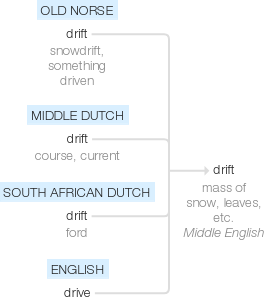Drift
Middle English (in the sense ‘mass of snow, leaves, etc.’): originally from Old Norse drift ‘snowdrift, something driven’; in later use from Middle Dutch drift ‘course, current’, and (in drift (sense 6 of the noun)) South African Dutch drift ‘ford’; related to drive.
wiktionary
From Middle English drift, dryft(“act of driving, drove, shower of rain or snow, impulse”), from Old English *drift(“drift”), from Proto-Germanic *driftiz(“drift”), from Proto-Indo-European *dʰreybʰ-(“to drive, push”). Equivalent to drive + -th; cognate with North Frisian drift(“drift”), Saterland Frisian Drift(“current, flow, stream, drift”), Dutch drift(“drift, passion, urge”), German Drift(“drift”) and Trift(“drove, pasture”), Swedish drift(“impulse, instinct”), Icelandic drift(“drift, snow-drift”).
etymonline
drift (n.)
early 14c., literally "a being driven" (at first of snow, rain, etc.); not recorded in Old English, it is either a suffixed form of drive (v.) (compare thrift/thrive) or borrowed from Old Norse drift "snow drift," or Middle Dutch drift "pasturage, drove, flock," both from Proto-Germanic *driftiz (source also of Danish and Swedish drift, German Trift), from PIE root *dhreibh- "to drive, push" (see drive (v.)).
"A being driven," hence "anything driven," especially a number of things or a heap of matter driven or moving together (mid-15c.). Figurative sense of "aim, intention, what one is getting at" (on the notion of "course, tendency") is from 1520s. Nautical sense of "deviation of a ship from its course in consequence of currents" is from 1670s. Meaning "controlled slide of a sports car" attested by 1955.
drift (v.)
late 16c., "to float or be driven along by a current," from drift (n.). Transitive sense of "to drive in heaps" is from 1610s. Figurative sense of "be passive and listless" is from 1822. Related: Drifted; drifting. To drift apart "gradually lose mutual affection" is by 1859.
